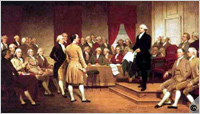03 May 2008
Constitutionalism

(The following article is taken from the U.S. Department of State publication, USA Democracy in Brief.)
A constitution, which states government's fundamental obligations and the limitations on state power, is a vital institution for any democracy.
Constitutions: Supreme Law
A constitution defines the basic purposes and aspirations of a society for the sake of the common welfare of the people. All citizens, including the nation's leaders, are subject to the nation's constitution, which stands as the supreme law of the land.
At a minimum, the constitution, which is usually codified in a single written document, establishes the authority of the national government, provides guarantees for fundamental human rights, and sets forth the government's basic operating procedures. Constitutions are often based on previously uncodified, but widely accepted, practices and precedents. For instance, the U.S. Constitution is based on concepts derived from British common law as well as 18th-century philosophers' attempts to define the rights of man.

Constitutionalism recognizes that democratic and accountable government must be coupled with clearly defined limits on the power of government. All laws, therefore, must be written in accordance with the constitution. In a democracy, a politically independent judiciary allows citizens to challenge laws they believe to be unconstitutional, and to seek court-ordered remedies for illegal actions by the government or its officials.
Despite their enduring, monumental qualities, constitutions must be capable of change and adaptation if they are to be more than admirable fossils. The world's oldest written constitution, that of the United States, consists of seven brief articles and 27 amendments – the first 10 of which are known as the Bill of Rights. This written document, however, is also the foundation for a vast "constitutional" structure of judicial decisions, statutes, presidential actions, and practices that has been erected over the past 200 years and which has kept the U.S. Constitution alive and relevant.
In general, there are two schools of thought about the process of amending, or changing, a nation's constitution. One holds that it is best to adopt a difficult procedure, requiring many steps and large majorities for amendment. As a result, the constitution is changed infrequently, and then only for compelling reasons that receive substantial public support. This is the U.S. model.
A simpler method of constitutional change, which many nations use, is to provide that any amendment may be adopted by approval of the legislature and passed by the voters at the next election. Constitutions revised in this fashion can become quite lengthy.
Federalism: Dispersal of Power
When free people choose to live under an agreed constitutional framework, it may be implemented in various ways. Some democracies have unitary administrations. Another solution is a federal system of government – power shared at the local, regional, and national levels.
The United States, for example, is a federal republic with states that have their own legal standing and authority independent of the federal government. Unlike the political subdivisions in nations such as Britain and France, which have a unitary political structure, American states cannot be abolished or changed by the federal government. Although power at the national level in the United States has grown significantly, states still possess significant responsibilities in fields such as education, health, transportation, and law enforcement. In turn, individual U.S. states have generally followed the federal model by delegating many functions, such as the operation of schools and police, to local communities.
The divisions of power and authority in a federal system are never neat and tidy – federal, state, and local agencies can all have overlapping and even conflicting agendas in areas such as education and criminal justice – but federalism can maximize opportunities for the citizen involvement so vital to the functioning of democratic society. Americans believe their federal structure protects their individual autonomy.
